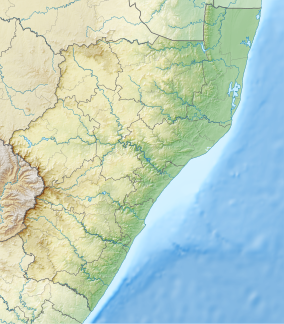| Alverstone Wildlife Park | |
|---|---|
Map of KwaZulu-Natal | |
| Location | Hillcrest, South Africa |
| Coordinates | 29°46′47″S30°43′51″E / 29.779833°S 30.7309149°E |
| Area | 100 ha (250 acres) |
| Established | 1997 |
| Governing body | eThekwini Metropolitan Municipality |
Alverstone Wildlife Park is a 100 hectare nature reserve near Hillcrest, KwaZulu-Natal, South Africa. [1] The reserve was created in 1997 by a group of neighbouring landowners. [2]
The wildlife park has a diverse ecosystem, which includes grasslands, a forest, and wetlands. [2] A number of mammals can be found in the reserve, including duiker, bushbuck, bushpig, civet, genet, mongoose and rock hyrax. [2] Herds of blesbok, blue wildebeest, impala and zebra have been introduced to the reserve. [2]
